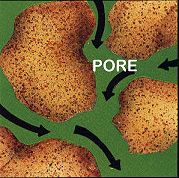Porosity and Permeability in Sedimentary Rocks
Porosity and permeability are related properties of any rock or loose sediment.
More specifically, porosity of a rock is a measure of its ability to hold a fluid. Mathematically, porosity is the open space in a rock divided by the total rock volume (solid and space).
Permeability is a measure of the amount of flow of a fluid through a rock.
Most oil and gas is produced from sandstones. Both porosity and permeability are needed for production. Porosity creates the spaces to hold the oil or gas. Permeability allows the oil and gas to flow out of the rock.
Porosity is normally expressed as a pecentage of the total rock which is taken up by pore space. For example, a sandstone may have 8% porosity.
Permeability in petroleum-producing rocks is usually expressed in units called millidarcys (one millidarcy is 1/1000 of a darcy). A petroleum reservoir may have permeability in the range of a few millidarcys up to several darcys.

Porosity and permeability are related properties of any rock or loose sediment.
More specifically, porosity of a rock is a measure of its ability to hold a fluid. Mathematically, porosity is the open space in a rock divided by the total rock volume (solid and space).
Permeability is a measure of the amount of flow of a fluid through a rock.
Most oil and gas is produced from sandstones. Both porosity and permeability are needed for production. Porosity creates the spaces to hold the oil or gas. Permeability allows the oil and gas to flow out of the rock.
Porosity is normally expressed as a pecentage of the total rock which is taken up by pore space. For example, a sandstone may have 8% porosity.
Permeability in petroleum-producing rocks is usually expressed in units called millidarcys (one millidarcy is 1/1000 of a darcy). A petroleum reservoir may have permeability in the range of a few millidarcys up to several darcys.






